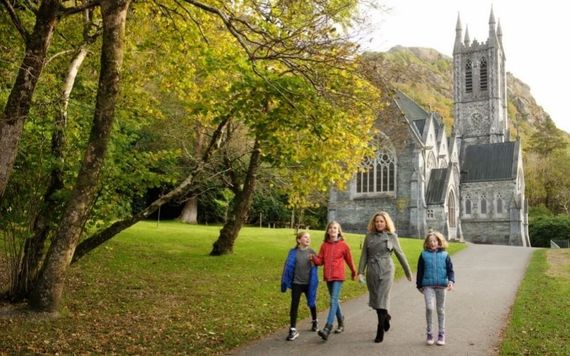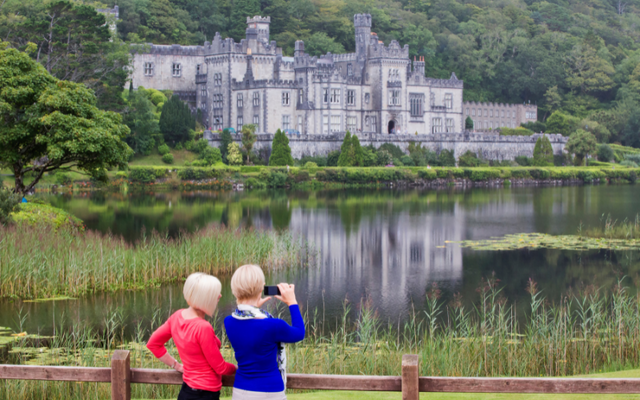We take a look at the history of Kylemore Abbey, in County Galway, and in particular its relationship with the Benedictine nuns.
The first sight of Kylemore Abbey is one of the most dramatic and memorable of all the tourist sights in Ireland. The castellated and turreted Abbey is nestled under a dramatic mountain-scape and fronted by a large lake. It has a picture-book appearance that is almost improbable – and its history shows that, indeed, there was nothing organic about the way in which this estate rose from the Connemara landscape.
The perfect positioning of the castle, the impact of the vista across Lough Pollacapull and the gardens, orchards and woodlands were all part of the vision and labor of Mitchell Henry, who owned the estate from 1867 to 1902. When the Benedictines arrived in 1920, the area had benefited from Henry’s financial investment; but it had also suffered the consequences of a century of famine, emigration, political unrest and poverty.
Landlords and nuns
The imbrication of two narratives – that of the fairy-tale castle and that of impoverished Connemara – had to be absorbed and fully understood by the Benedictines if they were to thrive in west Connaught. As women who belonged to one of the "English convents in exile", they were now trying to put down permanent roots in Ireland.
This article was originally published in Ireland of the Welcomes magazine. Subscribe now!
Somehow, they would have to become landlords on a vast estate, while continuing their commitment to living a simple life of prayer and teaching. Somehow, they would need their neighbors to see them as women of God and not as a group of elite outsiders who were about to determine the future of many local families whose livelihoods depended on the Kylemore estate.
Additionally, Wexford was very different from Connemara and their brief time in Macmine was poor preparation for life in the remote monastery on the side of a lake. Positioned in one of the farthest points of west Galway, Kylemore in the 19th century was part of the Archdiocese of Tuam, which covered a vast geographical area of some 1,400,000 acres and was divided into seven deaneries and 51 parishes. The Kylemore estate and lands fell within the parish of Ballynakill, in the Clifden deanery. It was a landscape of mountains, lakes, heather and rock.

Kylemore Abbey and Gardens.
A few large estates, in Clifden, Renvyle and Letterfrack, gave employment to dozens of servants. Tenant laborers who worked the land were, to a considerable degree, at the mercy of their landlords. Typical farms in west Galway in the mid-19th century were small in size (five to 15 acres) and each farmer had a cow, a pig and a few sheep. Some families were involved in kelp making, sea fishing and basket making. The area was mainly populated by monoglot Irish speakers, literacy levels were low and there was little formal schooling. In the 1820s, a road-building scheme opened up parts of west Mayo and west Galway, and small piers around the coastline were developed. Relief works operated by the Connemara in the 19th century.
Education
Religions, Education and the Development of West Galway Education in the Archdiocese of Tuam was somewhat ad hoc at the start of the 19th century. Landlords on some large estates tried to provide tuition for the children of their laborers and some Protestant landlords recognized that Catholic educators would be more acceptable to many of their tenants. For example, the Third Order of St Francis (Franciscans) were invited to Mountbellew in 1818 by Christopher Grattan Bellew, the local landlord, to educate the poor. In Carna, a Presbyterian, Major Forbes, offered his home to the Mercy Sisters to start a school when he returned to England. Education was also provided by Protestant education societies, such as the Irish Church Missions, whose mission was overtly proselytizing.

Love Irish history? Share your favorite stories with other history buffs in the IrishCentral History Facebook group.
Nevertheless, attendance at school was low; in 1834, it was calculated that only 12 percent of the school-age population in the Clifden deanery was enrolled in a school. This was despite the fact that, three years earlier, a state-funded non-denominational system of National Education had been established in Ireland.
In the Archdiocese of Tuam, however, this new system was denounced by Archbishop McHale, who perceived it as anti-Catholic. Throughout his long period as archbishop, he refused to cooperate with those who wanted to establish non-denominational schools and prevented their success in west Galway. Instead, he encouraged the expansion of Catholic religious orders, such as the Sisters of Mercy and the Franciscan Brothers. For example, the Sisters of Mercy opened a school for the poor in Castlebar in 1854 and an orphanage in Tuam in 1860.
By 1861, they were running a free school, a pay school and an orphanage in Clifden. A few years later, they opened another convent and school in Ballinrobe. Despite some improvements in education provision, west Galway and west Mayo experienced persistent poverty and unemployment which, together with the devastating impact of several famines, forced thousands of people to emigrate, sometimes with the aid of emigration societies.

Kylemore Abbey.
Land League
The second half of the 19th century witnessed a dramatic population decline in west Connaught: a wave of emigration followed the famine of 1877–9, during which some 10,000 westerners were "removed under the supervision of the Quaker banker, James Hack Tuke".
Famine, poor harvests and evictions also resulted in widespread dissatisfaction in Irish rural life. In 1879, the Irish National Land League was founded, under the leadership of Charles Stewart Parnell and Michael Davitt, with the aim of reducing rents and convincing the government that tenant proprietorship was the best way to improve the lot of the rural poor.
In Clifden, a branch of the Land League was formed in September 1879, and in 1880 a branch was formed in Letterfrack, close to Kylemore. In 1881, Gladstone’s Land Act was passed, granting ‘the three Fs’: fair rent, the fixity of tenure and free sale. The Irish Land Commission was formed and authorized to advance capital to tenants, to help them purchase their holdings. The Land Commission, together with the Congested Districts Board which was established in 1891, brought about a change of land ownership in many parts of the West, though in Connemara the transfer of land proprietorship from landlord to tenant had limited success.
This article was originally published in Ireland of the Welcomes magazine. Subscribe now!
It was against this backdrop of political unease, famine, emigration and social change that Mitchell Henry, the English-born son of Irish parents, purchased the Kylemore estate and began a program of land reform that would eventually be continued by the Benedictine nuns and that would have a lasting impact on the surrounding area.
* An extract from the book "The Benedictine Nuns and Kylemore Abbey: A History" by Deirdre Raftery & Catherine Kilbride (Irish Academic Press)
Here's a short travel slot on Kylemore Abbey and the surrounding area:




Comments